 |
for S/N 1 thru 200
Version 2 of the 1W-20 (S/N 481-488) Latest version of the 1W-20 (S/N greater than 500) Join the 1Watters QRPp email list See who is QRV on the QRV webpage Last Updated Tue, 13 Jul 2021 17:11:18 -0400 Always check the Addendum Section for updates |  |
Build this 20 Meter QRPp Transceiver for $44
Designed for 1 Watt output on 20 Meters using 12 VDC
VXO Frequency Range is approximately 14,056 to 14,061 kHz
Full QSK, Dual Conversion Design
Includes built in keyer IC
Instrucciones PDF en español presentados por Jon, EA2SN
PDF Instructions in English
Chuck Adams, K7QO, documents his building of S/N 108 (a big 101 MegaBytes)
1Watter Block Diagram submitted by Stuckey McIntosh, KV4UR (107 KiloBytes)
The purpose of this transceiver is to provide a high quality
inexpensive transceiver for achieving DXCC and WAS via QRPp
This transceiver was designed for home and portable operation.
The name of this radio is "The One Watter" or "1Watter".
The Xcvr has low noise and is very sensitive and selective.
Minimum Discernible Signal or MDS is -137dBm (Independently Verified)
The VXO covers both sides of the standard 20 meter QRP calling frequency.
The PCB size is only 2.5" (63,5 mm) by 3.8" (96,5 mm)
I would like to thank Chuck Adams, K7QO for suggesting the new 20 meter kit
and appreciate his help testing it to remove all the bugs and bad smoke.
He has some great pictures on his website at http://www.k7qo.net/onewatter1.html
and a 10 part youtube video series 1Watter Transceiver Build, Phase 1 by K7QO
My personal operating experiences including QRPp WAS, QRPp DXCC and
other Owner's Pictures and data is at http://1watters.com
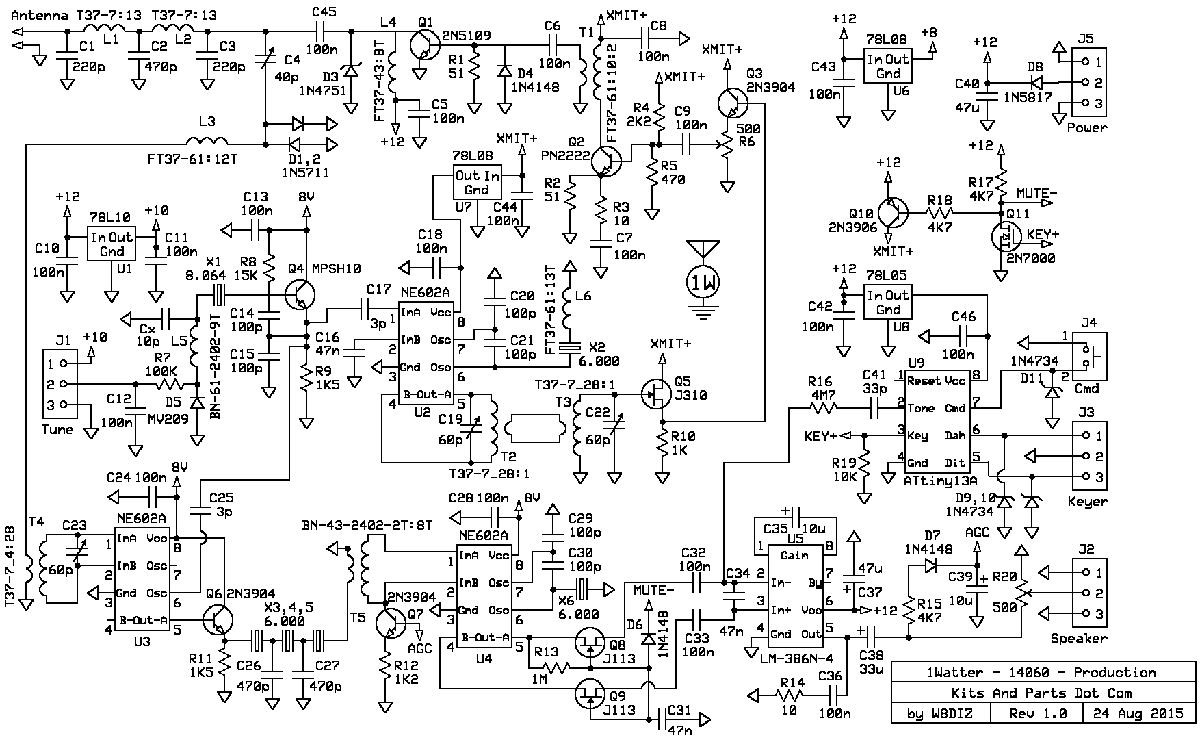
Full Size Schematic
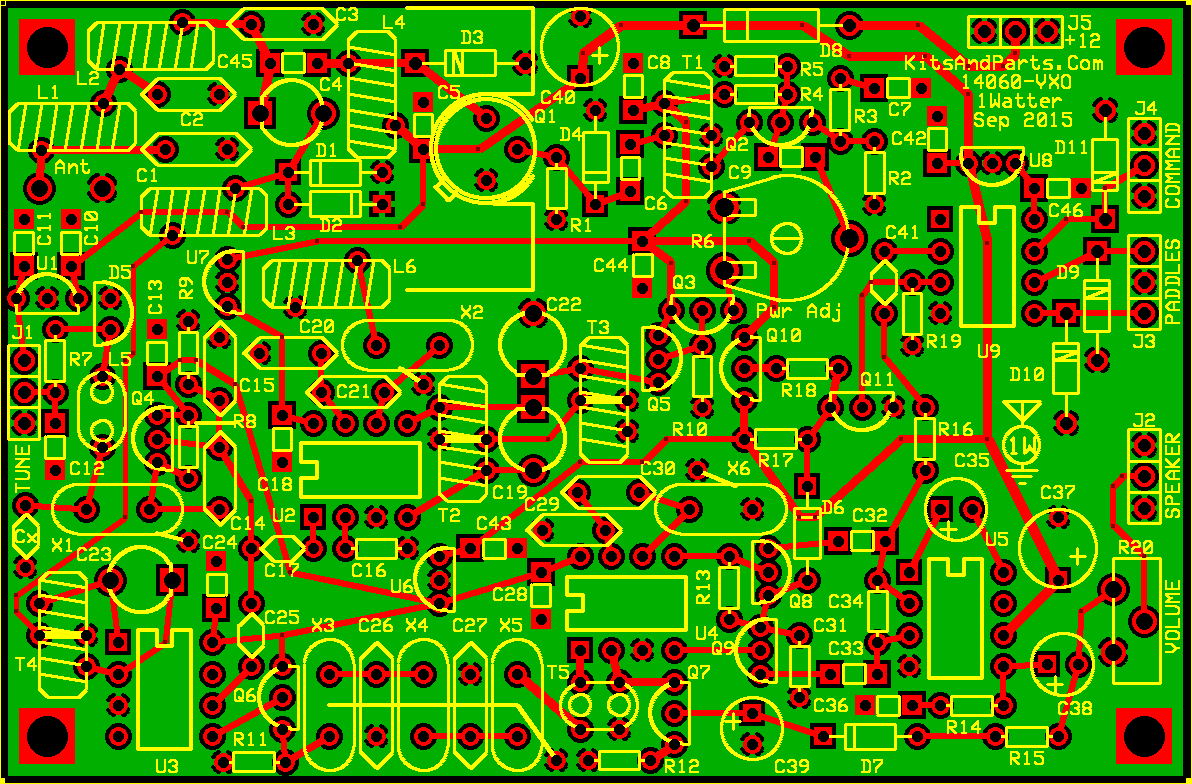
Building Instructions:
DO NOT REMOVE ANY PARTS FROM THE PLASTIC BAGS UNTIL INSTRUCTED TO DO SO
1. Be careful if you inventory the parts; they are small and easy to lose. Parts List
Parts like the SMT capacitors will include extra pieces in case you drop one (lost forever)
Do not mix up the toroids between the plastic bags.
Keep all toroids in their plastic bags until called for installation.
If you are missing any parts, contact me immediately. I will ship the parts the same day.
If you find extra parts in the kit, check the Addendum else throw them in your junk box.
This kit includes all parts to create a functioning transceiver EXCEPT the tune pot.
Included parts are: 2 phone jacks, a bnc jack, a push-button, volume control pot, magnet wire and heat sink.
This kit uses four (4) all black ferrite toroids. One (1) FT37-43 and three (3) FT37-61 toroids; they look the same.
The FT37-43 is included in the bag with the SMT capacitors.
Mark the bag with the SMT caps as "-43" and the bag with the resistors as "-61"
This will help with identification later on when installing inductors and transformers.
Install the parts in the order per this document to prevent mechanical installation problems later.
Each 1Watter is provided with a Serial Number, which is attached to the bag holding the PCB and magnet wire
Attach the label to the rear of your 1Watter enclosure or wherever suitable
The Serial Number may later be used for tracking 1Watter QSO contests.
This kit requires the following items to complete the kit:
hook-up wire/coax to connect the PCB to the chasis and an optional power on/off switch and optional case.
Any Addendums will be listed by date at the end of this document
2. Install all SMT capacitors
These capacitors are easy to install, especially if you have some kind of part holding/positioning tool.
I find a plain wooden toothpick will hold the 1206 size caps while soldering.
There are 20 pieces 100n capacitors on the PCB (1 or 2 extra in the bag)
Do not install C7
____C5,6,8,9,10,11,12,13,18,24,28,32,33,36,42,43,44,45,46
3. Install all 1/8 Watt Resistors.
You will need a magnifying device to verify the resistor color codes.
Be careful not to mix up the 1K5 & 15K and the 1K & 10K resistors.
Bend the resistor leads a sharp 90 degrees from the body of the resistors.
R20, the volume control will be connected later.
Save 6 cut resistor leads to ground the crystal cases later.
Do not install R3
____R1,2: 51 Green-Brown-Black-Gold
____R3: not installed
____R4: 2K2 Red-Red-Red-Gold
____R5: 470 Yellow-Violet-Brown-Gold
____R6: 500 Horizontal mounted pot (in hardware bag)
____R7: 100K Brown-Black-Yellow-Gold
____R8: 15K Brown-Green-Orange-Gold
____R9,11: 1K5 Brown-Green-Red-Gold
____R10: 1K Brown-Black-Red-Gold
____R12: 1K2 Brown-Red-Red-Gold
____R13: 1M Brown-Black-Green-Gold
____R14: 10 or 4R7 Brown-Black-Black-Gold or Yellow-Violet-Gold-Gold - See Addendum
____R16: 4M7 Yellow-Violet-Green-Gold
____R15,17,18: 4K7 Yellow-Violet-Red-Gold
____R19: 10K Brown-Black-Orange-Gold
4. Install all Diodes - observe polarity.
____D1,2: 1N5711 blue glass diodes
____D3: 1N4751 red glass diode with thick leads
____D4,6,7: 1N4148 red glass diodes with thin leads
____D5: MV209 varactor - leave 1/8 inch (3 mm) space between the PCB and diode body
____D8: 1N5817 larger black diode with thick leads
____D9,10,11: 1N4734 red glass diode with thick leads
5. Install all IC sockets - observe polarity.
____U2,3,4,5,9: Match the notch on the IC socket with the pattern on the PCB
6. Install all remaining capacitors in the order shown.
____C4: 40p yellow trimmer cap - flat side into square hole
____C19,22,23: 60p brown trimmer caps - flat side into square hole
____C1,3: 220p labeled 221J NPO disk cap
____C2,26,27: 470p labeled 471J SL disk cap
____C14,15,20,21,29,30: 100p labeled 101J NPO disk cap
____C16,31,34: 47n labeled 473 small yellow cap
____C17,25: 3p labeled 3 dark tan disk cap
____C35,39: 10uF black electrolytic - observe polarity
____C37,40: 47uF blue electrolytic - observe polarity
____C38: 33uF black electrolytic - observe polarity
Do not solder the C41 capacitor; insert the capacitor; clip leads to 1/16 inch
from bottom of the PCB and spread leads to prevent the capacitor from falling out.
You may wish to change this capacitor later when listening to sidetone volume.
____C41: 33p labeled 33J NPO dark tan disk cap
7. Install all Voltage Regulators and Transistors
Do not install Q1 at this time.
____U1: 78L10 voltage regulator; note orientation on the PCB
____U6,7: 78L08 voltage regulator; note orientation on the PCB
____U8: 78L05 voltage regulator; note orientation on the PCB
Temporarily connect a +12V source in series with a 100-200 ohm current
limiting resistor to J5-2 pad and power supply ground to J5-3 pad (ground)
Measure the output voltages of U1 (10V), U-6 (8V) and U-8(5V) to make sure they are correct.
Temporarily put a clipped resistor lead from emitter to collector of switch transistor location Q10
Measure the output voltage of U7 (8V) to make sure it is are correct.
Remove the clipped resistor lead and remove the power source and continue with parts installation.
____Q2: PN2222
____Q3,6,7: 2N3904
____Q4: MPSH10
____Q5: J310
____Q8,9: J113
____Q10: 2N3906
____Q11: 2N7000 - CAUTION...static sensitive
8. Install all five 8-pin DIP ICs.
____U2: NE602A balanced mixer; the dot positioned towards C18
____U3: NE602A balanced mixer; the dot positioned towards C23
____U4: NE602A balanced mixer; the dot positioned towards C28
____U5: LM386N-4 audio amplifier; the dot positioned towards C32
____U9: ATtiny13A Keyer with Sidetone; the dot positioned towards C42
9. Wind and install all Toroid Inductors. Wind all wires on the toroids clockwise.
9.1 Install inductors L1 & L2
Cut 10" of #26 wire.
____L1,2: Wind 13 turns of #26 red wire on an T37-7 white toroid, tightly spaced.
Trim the wires of L1 to a half inch each.
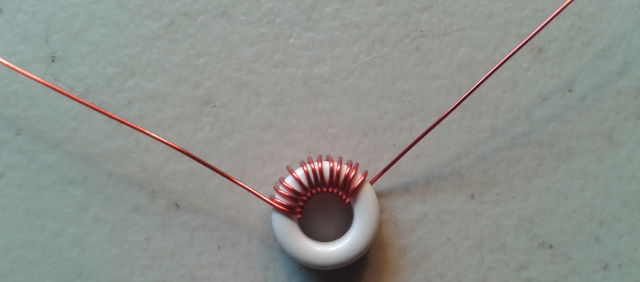
Tin & Strip the insulation to the base of the toroid using a hot solder pencil.
Spread the turns over most of the toroid

Install L1 & L2 into the PCB, pull the leads tight using needle nose pliers, solder and trim
You should be able to straighten the toroid to match the outline on the PCB
9.2 Install transformer T4
Cut 16" of #30 red wire and 5 inches of #27 green wire.
____T4: Wind 28 turns of #30 red wire on an T37-7 white toroid, tightly spaced.
Trim the #30 wires of T4 to one inch.
Wind 4 turns of #27 green wire on an T37-7 white toroid, tightly spaced.
Trim the #27 wires of T4 to a half inch each.

Tin & Strip the insulation to the base of the toroid using a hot solder pencil.
Install T4 into the PCB, pull the leads tight using needle nose pliers, solder and trim
You should be able to straighten the toroid to match the outline on the PCB
9.3 Install transformer T3 (Identical to T2)
Cut 16" of #30 red wire and 3 inches of #27 green wire.
____T3: Wind 28 turns of #30 red wire on an T37-7 white toroid, tightly spaced.
Trim the #30 wires of T3 to one inch.
Tin & Strip the insulation to the base of the toroid using a hot solder pencil.
Tin & Strip the insulation off the center one inch of the 3 inch green wire.
Fold the 3 inch wire in half and place thru T3
Install T3 with the #30 wires into the outside (upper and lower) holes on the PCB
and the single turn #27 wire thru the center holes of the PCB for T3
pull the leads tight using needle nose pliers, solder and trim
You should be able to straighten the toroid to match the outline on the PCB
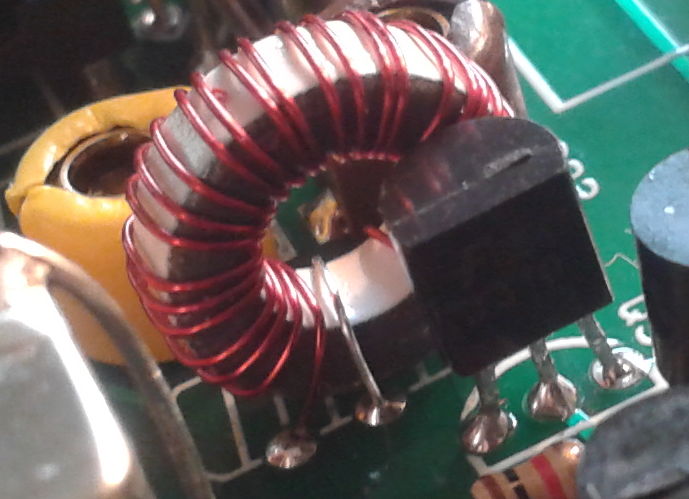
9.4 Install transformer T2 (Identical to T3)
Cut 16" of #30 red wire and 3 inches of #27 green wire.
____T2: Wind 28 turns of #30 red wire on an T37-7 white toroid, tightly spaced.
Trim the #30 wires of T2 to one inch.
Tin & Strip the insulation to the base of the toroid using a hot solder pencil.
Tin & Strip the insulation off the center one inch of the 3 inch green wire.
Fold the 3 inch wire in half and place thru T2
Install T2 with the #30 wires into the outside (upper and lower) holes on the PCB
and the single turn #27 wire thru the center holes of the PCB for T2
pull the leads tight using needle nose pliers, solder and trim
You should be able to straighten the toroid to match the outline on the PCB
9.5 Install inductor L4
Cut 10" of #27 green wire.
____L4: Wind 8 turns of #27 green wire on an FT37-43 black ferrite toroid, tightly spaced.
The FT37-43 black ferrite toroid is packed in the bag with the SMT caps
Trim the wires of L4 to a half inch each.
Tin & Strip the insulation to the base of the toroid using a hot solder pencil.
Spread the turns over most of the toroid
Install L4 into the PCB, pull the leads tight using needle nose pliers, solder and trim
You should be able to straighten the toroid to match the outline on the PCB
9.6 Install transformer T1 (similar to T4 but different turns an wire size)
Cut 10" of #26 red wire and 4 inches of #27 green wire.
____T1: Wind 10 turns of #26 red wire on an FT37-61 black ferrite toroid, tightly spaced.
The FT37-61 black ferrite toroids are packed in the bag with the resistors
Trim the #26 red wires of T1 to one inch.
Wind 2 turns of #27 green wire on an FT37-61 black toroid, tightly spaced.
Trim the #27 green wires of T1 to a half inch.
Tin & Strip the insulation to the base of the toroid using a hot solder pencil.
Install T1 with the #26 wires into the outside (upper and lower) holes on the PCB
and the dual turn #27 wire thru the center holes of the PCB for T1
Pull the leads tight using needle nose pliers, solder and trim
You should be able to straighten the toroid to match the outline on the PCB
9.7 Install inductor L3
Cut 10" of #26 red wire.
____L3: Wind 12 turns of #26 red wire on an T37-61 black ferrite toroid, tightly spaced.
The FT37-61 black ferrite toroids are packed in the bag with the resistors
Trim the wires of L3 to a half inch each.
Tin & Strip the insulation to the base of the toroid using a hot solder pencil.
Spread the turns over most of the toroid
Install L3 into the PCB, pull the leads tight using needle nose pliers, solder and trim
You should be able to straighten the toroid to match the outline on the PCB
9.8 Install inductor L6
Cut 10" of #26 red wire.
____L6: Wind 13 turns of #26 red wire on an T37-61 black ferrite toroid, tightly spaced.
The FT37-61 black ferrite toroids are packed in the bag with the resistors
Trim the wires of L6 to a half inch each.
Tin & Strip the insulation to the base of the toroid using a hot solder pencil.
Spread the turns over most of the toroid
Install L6 into the PCB, pull the leads tight using needle nose pliers, solder and trim
You should be able to straighten the toroid to match the outline on the PCB
9.9 Install inductor L5. This inductor determines the upper and lower frequencies of the 1Watter.
9 Turns on L5 for a frequency span from 14,055.9 to 14,060.8 kHz
8 Turns on L5 for a frequency span from 14,057.9 to 14,062.5 kHz
Cut 9" of #34 red wire.
____L5: Wind 9 (recommended) or 8 turns of #34 red wire on an BN-61-2402 black ferrite binocular.
The BN-61-2402 black ferrite binocular is packed in the bag with the resistors
Trim the wires of L5 to a half inch each.
Tin & Strip the insulation to the base of the toroid using a hot solder pencil.
Install L5 into the PCB, pull the leads tight using needle nose pliers, solder and trim
9.10 Install transformer T5
Cut 9" of #34 red wire and 4" of #30 red wire.
____T5: Wind 8 turns of #34 red wire on an BN-43-2402 black ferrite binocular.
The BN-43-2402 black ferrite binocular is packed in the bag with the SMT caps





Trim the red wires of T5 to one inch each.
Wind 2 turns of #30 red wire on the BN-43-2402 black ferrite binocular.
Trim the #30 wires of T5 to one half inch each.
Tin & Strip the insulation on all 4 wires to the base of the binocular.
The #34 wire leads for the 8 Turn winding go to the two pads closest to the IC, Pins 1 and 2.
The #30 rire leads go to the two pads farthest away from the IC or toward the bottom of the PCB.
Install T5 into the PCB, pull the leads tight using needle nose pliers, solder and trim.
10. Install all Crystals.
There are 5 pieces of 6.000 mHz crystals included in the kit.
These crystals are graded for frequency and resistance.
If you find a crystal with a black dot, install it in X6.
If you find 2 crystals with black dots, install in X2 & X6.
The Filter Crystals X3,4,5 should not have a black dot.
When installing the crystals, tilt the crystals about 20 degrees while soldering
This will raise the crystal a small bit above the PCB after straightening
and will prevent trace shorts to the case of the crystal
Do not overheat the crystals.
____X1: 8.064 crystal
____X3,4,5: 6.000 without the black mark (highly matched and quality checked)
____X2,6: 6.000 - may have a black mark
When soldering the crystal cases to ground, do not overheat the crystals
____X1 includes a ground connect wire. Solder into the ground hole (lower right)
____Solder one resistor lead across the top of crystals X3,4,5
____Solder one resistor lead from the top of X5 to the ground below (lower right)
____Solder one resistor lead from the top of X2 to the ground below (lower right)
____Solder one resistor lead from the top of X6 to the ground below (upper left)
11. Connections.
Recommend chassis/enclosures (Black Color) for the 1Watter is TBD
The TenTec TP/TPB/TPC-19 ($7.81) was ideal for this project but no longer produced.
Connect the 500 ohm volume pot (R20) using any insulated wire.
Connect the volume control wiper to the center (R20) on the PCB.
Connect a user supplied pot (5K or 10K or 100K or 1 Meg) to the "Tune" connector J1.
Connect the tune control wiper to the center hole on J1.
Connect a Speaker or Headphones to J2 via one of the 3.5 mm phono connectors.
The outside connections on J2 are ground.
Connect the provided BNC connector to the "Ant" connection next to L1 on the PCB.
Connect paddles or a straight key to J3 via the other 3.5 mm phono connector
Connect the Push Button, one wire to the center of J4, the other wire to one of the ground connections
Before you apply power to the 1Watter, make sure your power polarity is correct
The 1Watter was designed to operate from a 12 volt Sealed Lead Acid Battery
Connect +12.6V volts (+/- 1 volt) to the holes in the upper right corner of the PCB.
12. Receiver Alignment.
Connect any antenna to the 1Watter. Anything from a 2 foot wire up a large antenna.
Apply power to the 1Watter and set the volume control to maximum.
Adjust C4 and C23, back and forth for maximum noise coming from the speaker/headphones.
If you connected an antenna, you may hear CW signals by tuning the Tune Pot.
13. Transmit Alignment using an Oscilloscope or a Calibrated Accurate Receiver
The band pass filter (X3,4,5) center frequency is 5,998.600 kHz +/- 100 Hz
The oscillator part of U2, X2 and L6 should match that frequency +/- 100 Hz.
Find a signal in the tune range of the transceiver. As you tune across the signal,
the loudest audio frequencies should be about 600 Hz +/- 100 Hz
If the loudest audio is too high then remove one turn on L6
If the loudest audio is too low then add one turn on L6
The recommended 13 turns should be OK for most users.
Next we will adjust for maximum carrier output. You will need a 20 meter receiver or an oscilloscope.
If you do not have either, we will align the transmitter after we install the final transistor.
The Tune Control Oscillator operates at 8,060 to 8,064 kHz
The Carrier Oscillator operates at 5,998.6 kHz
These two signals are mixed to produce the 14,060 +- kHz transceiver frequency, but
the mixer also produces other frequencies that must be rejected.
Adjust the power control R6 to the 1:00 PM position towards R3
Preset C19 for maximum capacitance
C19 has broad tuning while C22 has very sharp tuning.
Preset the tune control to mid position
Place the Keyer into straight key mode
While listening to a receiver near 14060 kHz or watching a scope at the junction of R1/D4,
adjust C22 to max signal on the scope or receiver.
If using a receiver, you may need to hunt for the actual signal; look at 14060 +- 3 kHz.
After finding the signal, readjust both C19 and C22 for maximum signal.
After alignment, C19 should be very near maximum capacitance
and C22 should be very near 40 percent capacitance.
Make sure that you have aligned the filter to the correct frequency and not an alternate
frequency generated by the transmit mixer. Measure the frequency using a scope of freq counter.
14. Install the RF Final Transistor Q1
____Q1: 2N5109 - leave 1/8 inch (3 mm) space between the PCB and transistor case
____Q1 heat sink: - push the heat sink over the case of Q1; align heat sink to match PCB pattern.
15. Sidetone volume setting.
The sidetone volume is fixed/set by R16,4M7 & C41,33p.
To lower sidetone volume, decrease the value of C41
To raise sidetone volume, increase the value of C41
Replacements for C41 are not included in the kit
____C41: Solder the capacitor and trim leads.
16. Transmit Final Alignment using milliamp meter
Connect a 50 ohm dummy load to the output of the transceiver and power up with 12V.
Place the keyer into straight key mode (see instructions below)
Connect xcvr to power supply through an amp meter, 250 mA or greater.
Key the transmitter and adjust R6 for exactly 250 milliamps.
If C19 & C22 were not aligned in a prior step then do so now by setin C19 to maximum capacitance
and ajusting C22 for maximum milliamps current. Adjust R6 to keep the current at 250 Ma.
repeat several times until you know that C19 & C22 are peaked and R6 is set for 250 Ma.
After alignment, C19 should be very near maximum capacitance
and C22 should be very near 40 percent capacitance.
If you have a wattmeter, insert it between the dummy load and the tranceiver.
It should measure very near 1 watt output.
You may also adjust R6 for 20 volts P-P on a scope.
It is recommended that you do not adjust R6 for more than 1 watt to prevent instability.
This completes the 1Watter Tranceiver alignment.
The 1Watter Service Manual
17. Optional modifications to and experiments with the 1Watter
17.1 QSK time delay adjustments
C31 determines the QSK time delay. The official value is 47n
but there is a bit of thumpyness in the audio when
sending dits and dahs. You can eliminate most of the thumpyness
by changing the value of C31 to 100n, a small disk cap labeled 104
This 104 cap is included in the kit.
17.2 NE602A gain increase for U3 and U4
You may increase the gain by placing a 27K or higher value resistor across pins 1 and 8 of U4
The 27K resistors are included in Kits S/N 103 and lower only
17.3 Sidetone frequency source
The sidetone on transmit is generated by the keyer IC; you select the audio frequency.
You can hear the true sidetone frequency offset, which is the difference between the BFO freq
and the transmit carrier freq, both from 6 MHz oscillators.
Remove R16, the 4M7 resistor between U9 and U5.
Connect a 22K resistor and a 10 pF cap (in series) between pin-4 of U4 and pin-2 of U5
What we are doing is sampling the receive signal around the mute circuit, Q8 and Q9.
Parts for this modification are not included in the kit
17.4 Frequency Range Mods
You may increase the frequency span of the 1Watter by increasing the number of turns on L5
Do this in half turn increments; too many turns and the oscillator stops working.
Add capacitance at Cx, between the crystal X1 and L5 and ground. Try 10-15 pF for starters.
18. The 1Watter Keyer Instructions
This is a very basic Iambic-Mode-B Keyer (ATmel AVR Assembler Source Code available upon request)
On power-Up, the keyer defaults to 15 WPM and a sidetone of 625 Hz and annunciates "1W" [ .---- .-- ] via Int'L Morse Code.
The internal timing oscillator in the Keyer Chip is an RC oscillator that runs at 9.6 MHz +/- 10 pct Factory Calibration.
Typical accuracy is +/- 5 percent; The accuracy can be impoved to +/- 2 percent if one takes the time to calibrate
the oscillator and reprogram the keyer chip. This procedure is too time consuming for 200 chips but may be OK for you.
The accuracy is typically +/- 5 pct so your sidetone may be off by +/- 5 pct and your keying WPM may also be off.
That means if you set the WPM speed to 20 WPM, you may actually have it set at 19 or 21 WPM; should not be a problem.
The keyer is placed into the "Command" mode by pressing and releasing the Cmd Button.
The keyer has the following commands available after pressing the Cmd Button:
"E" (.) or "T" (-) Toggles between normal keyer and straight key mode, acknowleged by annunciating "S" (for Straight Key Mode) in code.
The keyer mode is NOT saved on power-down.
"R" (.-.) Toggles between normal and reverse paddles keys, acknowleged by annunciating "P" (for normal paddles) or "X" (for reversed paddles) in code.
The paddles (normal or reverse) are saved on power-down.
"S" (...) Set keyer speed in WPM. Speed is entered as two numerical digits.
After sending the "S" command, the keyer sends a DIT (e) as a prompt for the first speed character (0-4)
After sending the first speed number, wait for another DIT (e) prompt and send the 2nd number (0-9)
Depending upon what you enter, you will hear a "?" for ERROR or an "R" for a "Roger" acknowlegement.
Valid keyer speeds are 1 to 45 WPM (good luck trying to send/use 1 WPM)
The keyer speed setting is saved on power-down.
"F" (..-.) Sets the sidetone frequency.
After sending the "F" command, the keyer sends a DIT (e) as a prompt for the tone character (0-9)
Depending upon what you enter, you will hear a "?" for ERROR or an "R" for a "Roger" acknowlegement.
The sidetone frequency setting is saved on power-down.
The following table equates the sidetone number with the sidetone frequency:
0 = 1000 Hz
1 = 833 Hz
2 = 714 Hz
3 = 625 Hz
4 = 555 Hz
5 = 500 Hz
6 = 455 Hz
7 = 417 Hz
8 = 385 Hz
9 = 357 hz
To Reset the Keyer to the Default mode, hold the Cmd button active until you hear "1W"
Then immediately release the Command Button, else you will send another Command request.
The 1Watter is now finished ... except for your first QSO.
The official 1Watter 20 meter hangout frequency is 14,059 kHz (I stole it from Chuck Adams)
Addendum Section:
Aug 16 2015 1100 - Because of possible transmit filter alignment difficulties, I rewrote the transmitter alignment instructions.
Aug 16 2015 1237 - There is too much gain in the transmitter chain making alignment difficult. Remove C7 from the driver circuit.
Aug 16 2015 1254 - Also removed R3 from the circuit since C7 has been removed (this is optional - not required).
Aug 27 2015 1503 - Altered the time of installation for C19 and C22
Sep 05 2015 2305 - If you have difficulty aligning C22, change T3 to 20 turns (remove 8 turns) and
install a 47 or 51 or 56 pF cap across C22 on the bottom of the PCB
A 56 pF cap is included with kits serial number greater than 133
Sep 19 2015 1430 - Change R14 from 10 ohms to 4R7 ohms to prevent audio oscillations at very high volume. Google search "Boucherot cell"
A 4R7 resisor is included with kits serial number greater than 154
Sep 22 2015 1818 - You may be able to reduce some transmit mixer distortion products by changing C17 from 3pF down to 1pF
This reduces the VXO signal to the transmit mixer U2
Search qrpp@1watters.com email list archive "How to improve NE602 distortion products" Sep. 22 2015.
Nov 16 2015 1259 - The Natural Sidetone Mod improves the audio quality and accuracy of the transmit sidetone frequency.
Perform this Mod after the 1Watter is built and tested.
Replace R16 with a 1M resistor.
Install a 4M7 ohm resistor on the bottom of the PCB across the Drain and Source of Q8
Install a 4M7 ohm resistor on the bottom of the PCB across the Drain and Source of Q9
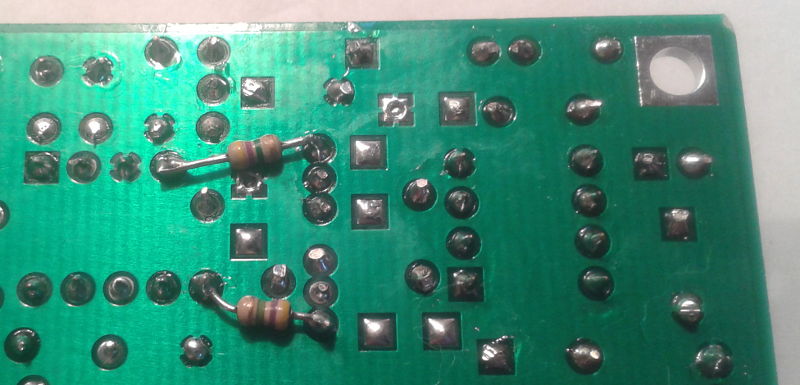
Variable capacitor settings:
| Maximum Capacitance | Midway Capacitance | Minimum Capacitance | |||
|---|---|---|---|---|---|
 | 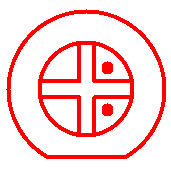 |  |
If you need an alignment tool for the trimmers, look up "GC 8608" - available at newark.com and onlinecomponents.com
| Frequency Range / Span vs L5 inductor turns
8.0 turns = 14,057,120 - 14,062,490 - stable 5.3 kHz span 8.5 turns = 14,055,240 - 14,062,030 - stable 6.8 kHz span 9.0 turns = 14,053,515 - 14,061,545 - stable 8.0 kHz span 9.5 turns = 14,050,830 - 14,060,830 - stable 10.0 kHz span 10.0 turns = 14,047,950 - 14,060,130 - stable 12.2 kHz span 10.5 turns = sample not taken 11.0 turns = 14,035,xxx - 14,057,760 - drifts at the low end only 12.0 turns = 14,013,xxx - 14,053 - drifts, especially at the low end I set my 1Watter to 8.5 turns |
End of Addendum Section: top